Turtle Burmation
Posted: February 26, 2024 Filed under: Gardening | Tags: Backyard Critters, nature photography, Southern Gardening 15 Comments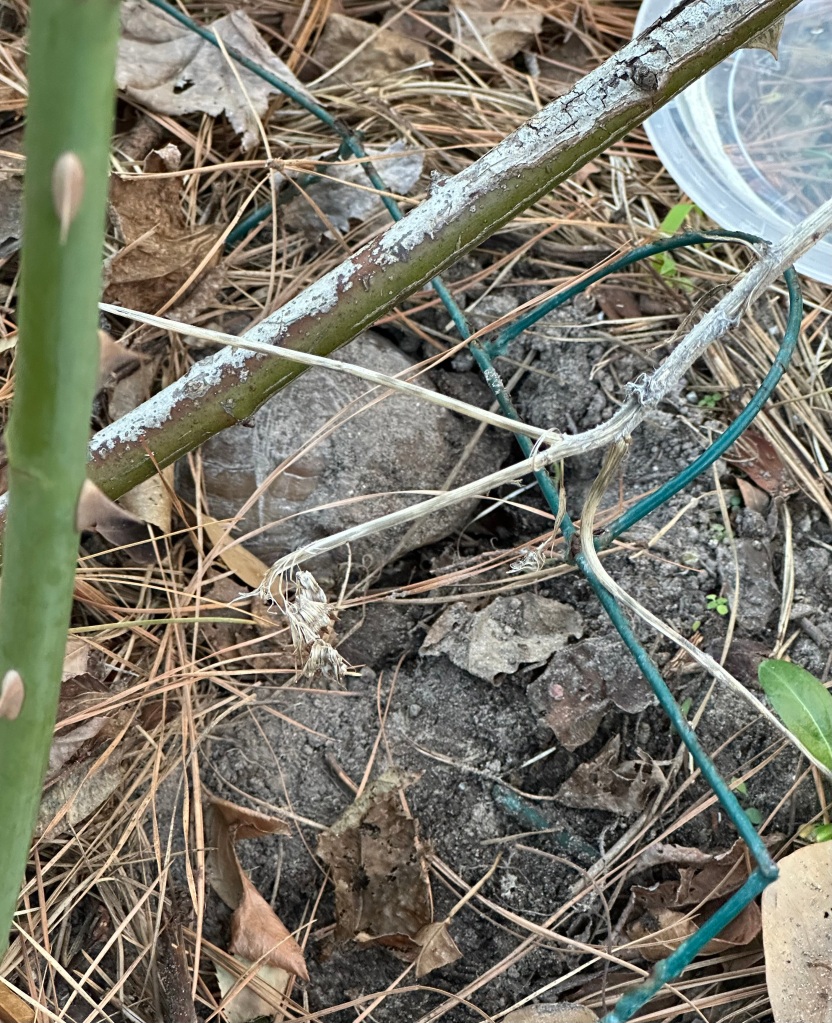
While working on my rose bush I noticed a muddy rock. Not remembering why I put it there I went to check it out.
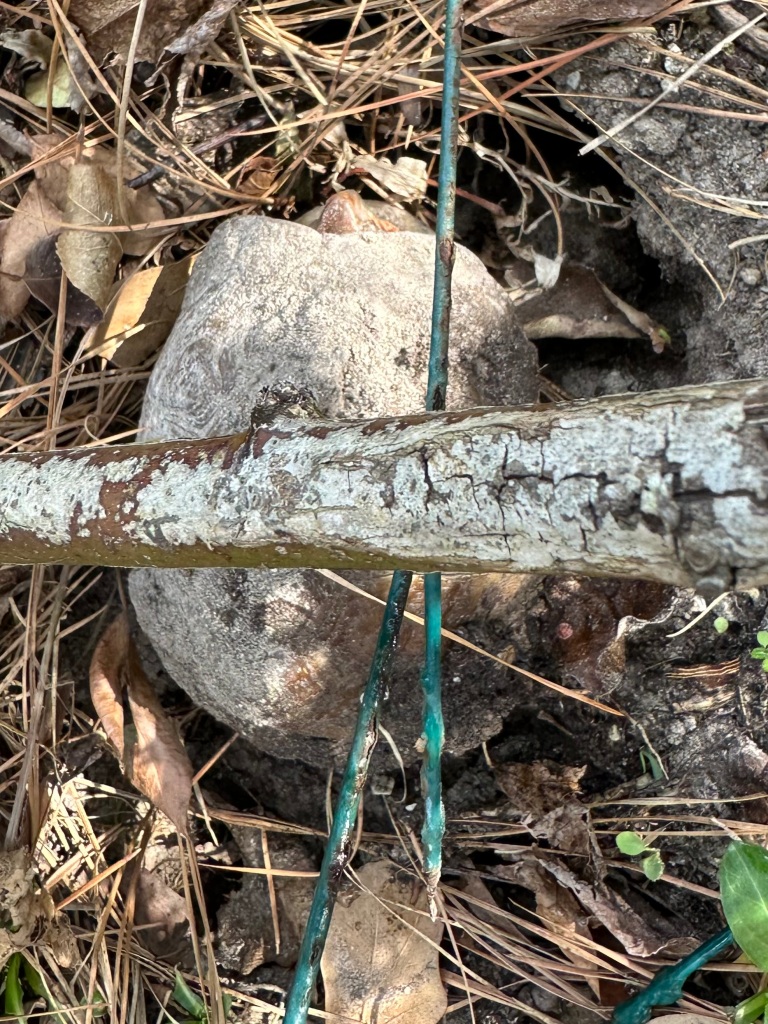
The rock was a box turtle that may be coming out of brumation or hibernation.
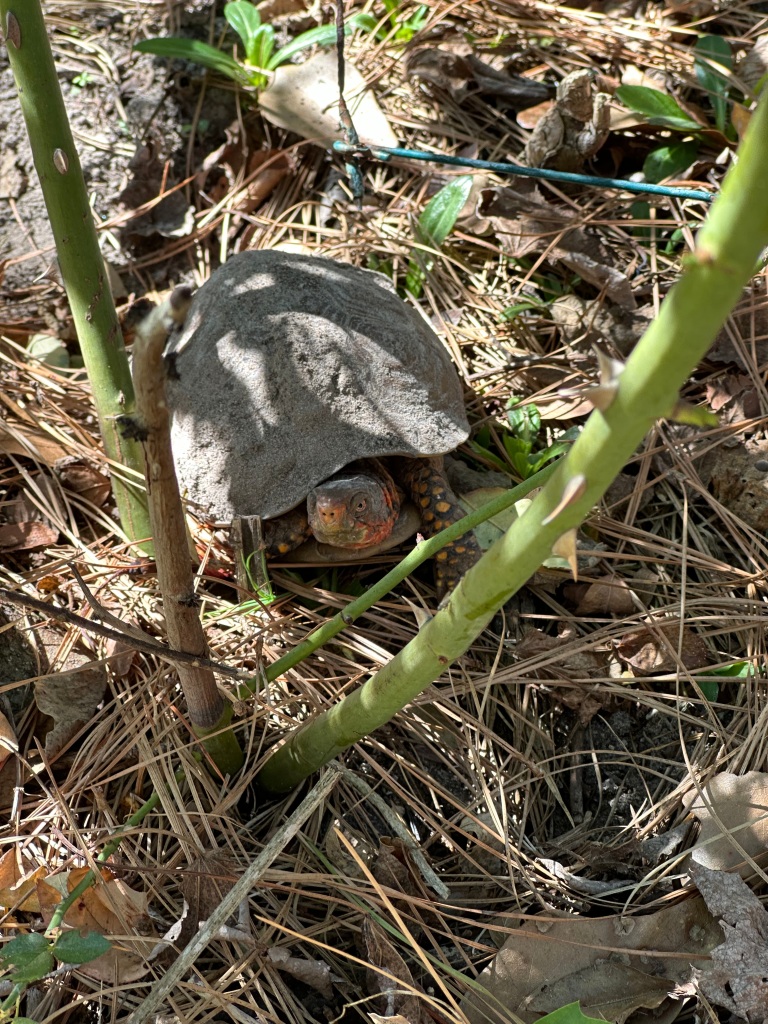
Maybe not happy that I disturbed it, the turtle moved a couple of feet to a sunny location.
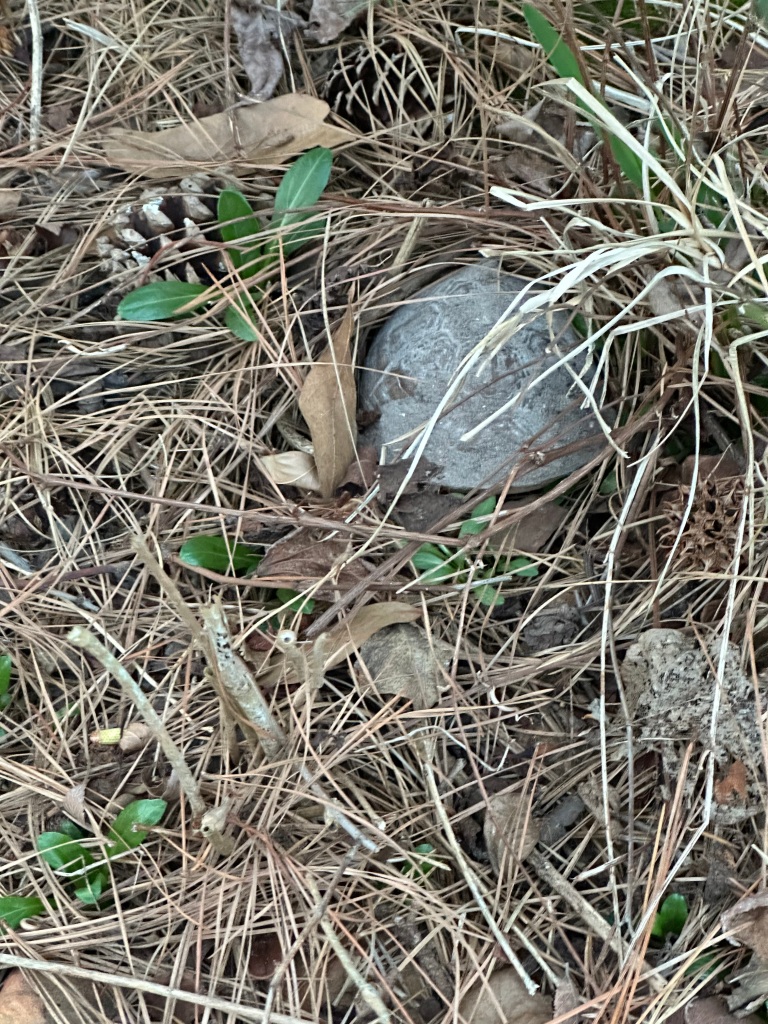
As the day ended I found the sleepy turtle had crawled back under the pine needles for the night.
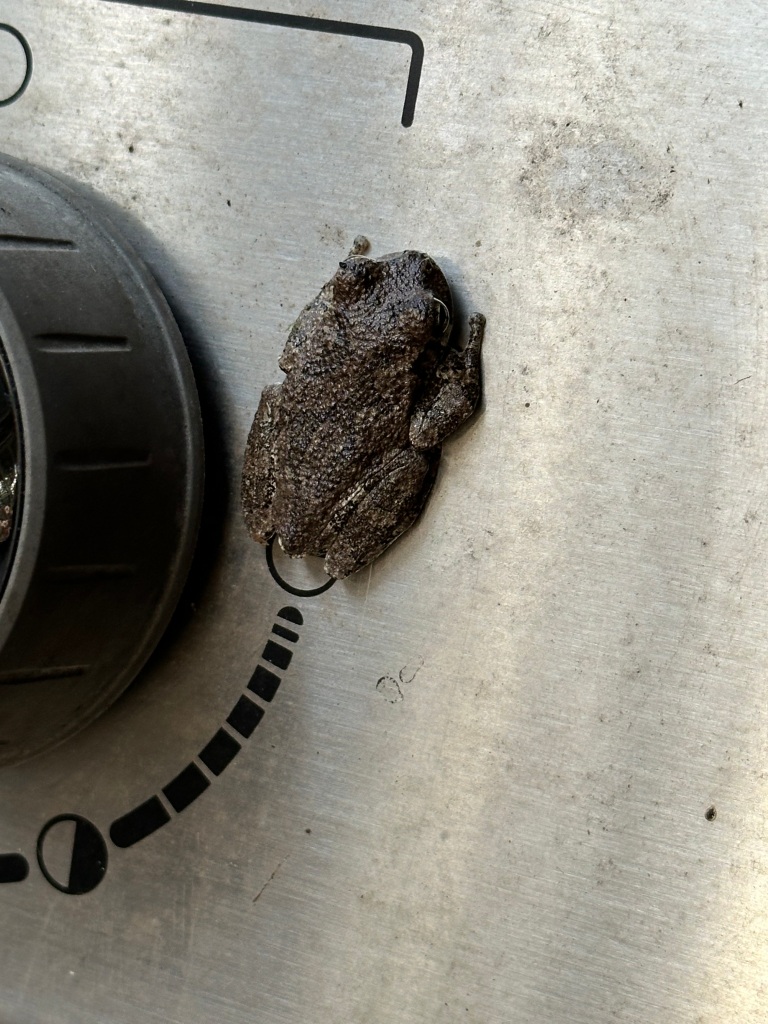
The weather was nice enough to fire up the grill for supper. As the cover was removed I found another sleepy creature. Of course, the little tree frog had to be removed to a safe location. The weather is warming this week, the days are lengthening and insects are hatching it’s time for my garden friends to come out of their winter sleep.
Backyard Wildlife
Posted: November 20, 2023 Filed under: Gardening | Tags: anole, Backyard Critters, Gulf Fritillary Butterfly, nature photography, Southern Leopard Frog 19 Comments
I had a very unusual interaction with an Anole. I was wearing my gardening gloves digging up some plants to move, when I felt what I thought was a thorn in my glove. I pulled the glove off and there was an Anole biting my skin. I have so many questions. Was the lizard in my glove when I put it on? Why didn’t I feel it? Could it have gotten into my tight glove while gardening? I keep my gloves hanging up, but I guess from now on I will shake them before I put them on.

After the Anole incident, I came across my frog friend staying very still while I was digging around it.

The sugar water feeder was busy with a bee and a butterfly. Occasionally, a butterfly will figure out how to get the sugar.

Gulf Fritillary Butterflies were enjoying the sunny day and I managed to get some decent photos.


Green on Green
Posted: August 29, 2023 Filed under: Gardening | Tags: Backyard Critters, Green Anole, nature photography, Southern Gardening, Subtropical Gardening 14 Comments
Green on green with my favorite lizard. A green anole is hanging out on a big leaf. The blue around its eye really pops. Click to enlarge.

I found this green anole licking up dewdrops.

When it was finished drinking, the lizard posed for its close-up.
Crawly Creatures
Posted: May 8, 2023 Filed under: Gardening | Tags: Backyard Critters, Gulf Coast gardening, Ladybug, nature photography, rosy wolf snail, Year-round gardening 16 Comments
I found this Two Stripe Spider in my water can. It is a very big spider about 2 inches long and for some reason was not bothered by me watering plants or filling the can back up.

The gigantic spider even made a web to catch bugs. Finding a spider in my watering can was bad enough, but I had no idea how many bugs were visiting it.

While weeding, a saw an interesting seed that moved a bit as I pulled weeds. I gave it a poke and it moved on its own and I realized it was an insect. It is sitting on a salvia leaf that is about an inch long. I have looked through insect pictures and could not find it, so if anyone can identify it let me know. (Try to ignore the pine needle under the bug.)

In the spring, mites get on plants which is a bonus for ladybugs.

One of my favorite creatures is the Rosy Wolf Snail. This mature one was looking for food which is other snails and slugs.

And again while weeding I found a baby Rosy Wolf Snail. I put it beside one of the mature empty shells had I found.
First Snake Sighting of the Year
Posted: April 10, 2023 Filed under: Gardening | Tags: Backyard Critters, Copperhead Snake, Gulf Coast gardening, nature photography, Southern Gardening 24 Comments
I had my first snake sighting for the year. This is a baby Copperhead.

I had been weeding an enclosed area around the Dancing Lady Gingers. I started weeding on the opposite side and the snake never moved. I was glad I had my gloves on as I was very close to the snake before it let me know it was there. Of course, I had to stop weeding for a photo session. I find that Copperheads usually just stay still and watch,
Sugar Line
Posted: January 22, 2023 Filed under: Gardening | Tags: Backyard Critters, Ladybug, nature photography, wasp 14 Comments
There was a bit of a lineup of insects trying to get some energy on a cold day.
The impatient wasp nipped the ladybug a couple times, but she would not budge.
The line was stalled.
When I checked back later, the ladybug had moved under the white ring and the wasp finally found the way to the sugar.
Someone is Watching Me
Posted: January 16, 2023 Filed under: Gardening | Tags: Backyard Critters, nature photography, possums 15 Comments
I was refilling the birdfeeder when I felt eyes watching me and sure enough, I looked up and saw a possum in the tree over the feeder. Then I noticed some movement on the ground and another possum was scurrying away. Normally, they are not out in the daylight and my family was concerned, but I did some research and found out possums rarely get rabies.

I have also been finding a lot of food wrapper trash in the backyard which is unusual. I can understand trash in the front from garage trucks and litterbugs, but I have a large front yard and a six-foot fence to get over before any street trash can reach the back. I think maybe I have found the culprits. Possums do like to raid trashcans.

One big mystery is do possums like beer? And can they crush a can when they are finished?
Squirrel Apocalypse or Helpful Pruning
Posted: December 12, 2022 Filed under: Gardening | Tags: Backyard Critters, Gulf Coast gardening, oak tree, squirrels 12 Comments
The oak tree planted twenty years ago has been prolific this fall in producing acorns. I am not the only one that noticed. The squirrels have been gathering acorns for weeks.

I can put up with the squirrels taking the acorns and digging holes all over my yard and garden beds, but to get the acorns they have been cutting off branches and covering the bed under the tree and front yard with them. I am not sure if all of this pruning will be helpful to my oak tree.
Critters and Plants
Posted: October 17, 2022 Filed under: Gardening | Tags: Backyard Critters, Green Anole, Gulf Coast gardening, Gulf Fritillary Butterfly, hummingbird moth, My Kitchen Window, nature photography, purple Oxalis, Swamp Sunflower 20 Comments
I had a week of notable critter encounters and stand-out plants. This green anole took a trip across the yard in a shaky wagon as I moved this plant from its summer spot in the woods. The little lizard is staying in its plant home and greets me every morning when I head outside.



I got a few somewhat good shots of the hummingbird moth. Usually, it is busy during the night, but I caught it out in the daytime. Click to get a better look at its wings.

I thought it was interesting that the purple oxalis found a way to grow out of the bottom of the pot.


A Gulf Fritillary butterfly has been hanging out on the hummingbird feeders. I was finally able to get close enough for a photo.

I have a love/hate relationship with Swamp Sunflowers. They are very invasive, and grow ten feet tall, but are so happy and sunny in the fall.


Back to odd anole habits. This lizard is my regular porch anole that clings to the window screens most of the day. As it turns out the lizzie likes to sleep on my weather stick at night. When I check on it in the early morning hours it will have actually changed positions. I feel fortunate to have such a variety of plants and wildlife in my backyard.
An Armadillo at Dawn
Posted: October 15, 2022 Filed under: Gardening | Tags: Armadillo, Backyard Critters, My Kitchen Window, nature photography, Southern Gardening 29 Comments
I was sipping my morning coffee and glancing out of the window when I noticed plants waving in an odd way. And then I saw the grey body that was causing the chaotic motion. It was the armadillo that dug a huge hole in my flower bed outside my kitchen window.

I quickly grabbed my cell phone and started my early morning armadillo chase. I managed to chase it under the fence into my neighbor’s yard. I didn’t feel too bad about that as they don’t have flower beds for the armadillo to dig up. I’m sure are some point it returned to its den on my side.
